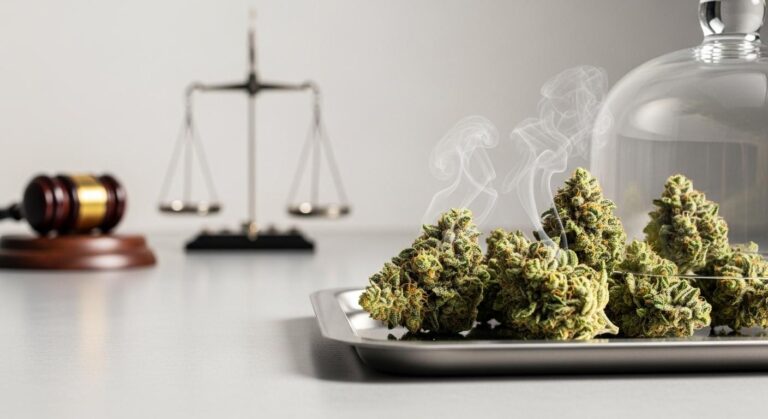Contents
- 1 Understanding THCa: The Non-psychoactive Compound
- 2 Benefits and Applications of Raw Cannabis
- 3 The Decarboxylation Process: Turning THCa into THC
- 4 Legal Status of THCa in Australia
- 5 Comparing THCa Products in the Market
- 6 Scientific Research on THCa
- 7 User Experience and Community Perspectives
- 8 Conclusion: Navigating the Future of THCa in Cannabis Culture
- 9 Key Points
Understanding THCa: The Non-psychoactive Compound
At first glance, THCa might seem like just another inscrutable jumble of letters in the ever-expanding cannabis alphabet soup. Yet, here’s where things get truly fascinating. THCa, or tetrahydrocannabinolic acid, naturally occurs in raw cannabis plants without giving you that telltale “high” typically associated with marijuana, courtesy of its psychoactive counterpart, THC. Imagine THCa as a shy cousin at a family reunion, quietly potent but unassuming until coaxed out.
Chemically speaking, THCa is slightly bulkier due to a carboxyl group (that’s a carbon atom double-bonded to an oxygen atom and single-bonded to a hydroxyl group—science, everyone). This difference accounts for its non-psychoactive nature. Although THCa doesn’t lead to intoxication, it’s not without merit. Research suggests potential therapeutic effects, such as anti-inflammatory and neuroprotective properties.
Benefits and Applications of Raw Cannabis
Enter raw cannabis, a leafy green that some swear rivals kale in its health benefits. When consumed in its raw form—say, tossed into a smoothie—it’s rich in THCa and devoid of the psychoactive effects commonly associated with its heated cousin. How’s that for guilt-free indulgence?
Therapeutically, raw cannabis offers a cornucopia of non-psychoactive cannabinoid benefits. Health enthusiasts praise its nutritional value, boasting vitamins, fiber, and a healthy dose of omega-3 and omega-6 fatty acids. Within medical and wellness communities, raw cannabis has sparked interest not just for its wellness perks but for its potential in holistic treatment plans.
The Decarboxylation Process: Turning THCa into THC
Now, let’s put on our culinary chemist hats. When you apply heat to THCa—whether through smoking, baking, or the audacious act of making cannabis-infused brownies—it undergoes decarboxylation. It’s essentially a fancy term for heating that transforms THCa into THC, unlocking its psychoactive potential.
Decarboxylation isn’t just some kitchen witchcraft; it’s a precise science. Factors, such as temperature and time, significantly affect how efficiently THCa is converted to THC. Think of it like roasting marshmallows—too little heat, and you miss out on gooey goodness; too much, and you’re left with an inedible char.
Legal Status of THCa in Australia
Australia’s legal landscape is a bit like navigating the outback on a moonless night: intriguing yet challenging. While federal law often frowns upon anything remotely resembling THC, THCa exists in a curious legal gray area. It’s not classified as a controlled substance primarily due to its non-psychoactive nature.
The nuances in cannabis regulations bring opportunities and challenges for consumers and manufacturers alike. Regulatory distinctions between THCa and THC impact both the legal status of cannabis products and the scope for research. Raw THCa might be legal, but turn up the heat to activate it into THC, and you enter a whole different jurisdictional jungle.
Comparing THCa Products in the Market
Strolling down the metaphorical aisles of the cannabis industry, you’ll encounter an array of products emphasizing THCa’s benefits. THCa flower and raw cannabis buds are gaining traction among consumers seeking therapeutic effects without psychoactive properties.
Purchasing THCa-rich products requires keen observance. The market is burgeoning with options, yet not all are created equal. Understanding the differences between THCa and THC-dominant products is essential for making informed decisions. Remember, authenticity and quality aren’t just buzzwords; they’re your safeguards against dubious claims.
Scientific Research on THCa
The scientific community is buzzing with curiosity about THCa. Recent studies hint at several promising medical applications, ranging from anti-inflammatory effects to potential uses in neuroprotection. However, due to cannabis laws, conducting detailed research on THCa remains a challenge.
Despite these hurdles, the future looks promising. Ongoing studies continue to probe into THCa’s therapeutic potential, and as regulations evolve, the scope for research is expected to expand. The moral of the story? Stay tuned—scientific validation may be just around the corner.
User Experience and Community Perspectives
Among the many voices championing THCa, personal anecdotes often shine the brightest. Users share stories of relief from chronic pain and inflammation without experiencing the psychoactive effects. The community speaks with optimism, viewing raw cannabis as a vital component of holistic health.
Education remains a cornerstone in shifting public perception. As more people explore raw cannabis options, support networks are evolving, fostering a culture of informed experimentation and shared learning.
THCa is carving out its niche in the tapestry of cannabis culture. As laws, science, and consumer interests continue to develop, the role of THCa could become more prominent. For consumers, the key to embracing this raw potential lies in balancing curiosity with caution and staying informed about legal and medical perspectives.
Anticipating future developments requires a dash of patience but also a firm grip on optimism. THCa’s journey in the market is just beginning, promising opportunities for those willing to explore this non-psychoactive frontier. In the end, perhaps we’ll find that in this quiet cousin, we’ve always had something quite profoundly powerful.
Key Points
- THCa is a non-psychoactive compound found in raw cannabis.
- Decarboxylation transforms THCa into psychoactive THC through heating.
- THCa’s therapeutic potential includes anti-inflammatory and neuroprotective properties.
- Australia’s legal environment for THCa is complex, requiring careful navigation.
- Consumer interest in THCa products is growing, emphasizing quality and authenticity.
- Scientific research on THCa is expanding, revealing promising medical applications.
- User experiences highlight the benefits of THCa without psychoactive effects.



